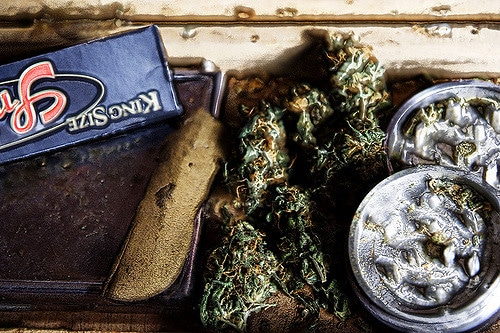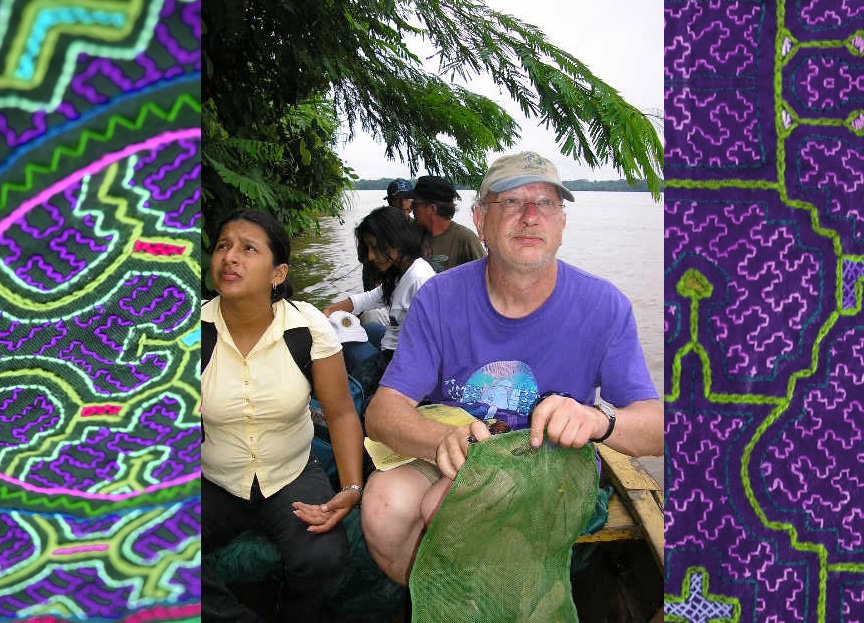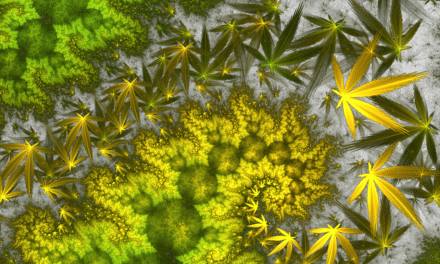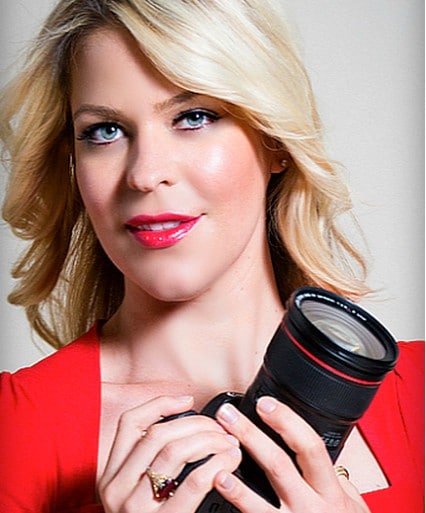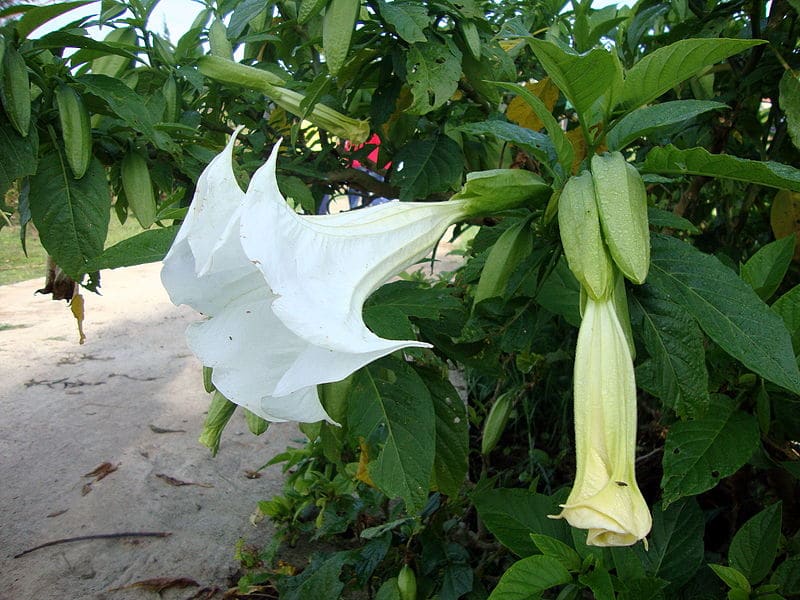
Sometimes brugmansia—known locally as toé—is added to ayahuasca brews to create the strong psychological effects popularized in Western stories. Image Source: Wikimedia user Prenn.
I first read about ayahuasca on erowid.org in 2002. Even though this medicine was gaining popularity at the time, none of my friends—experienced psychonauts—had used it or even heard about it. Now, when ayahuasca comes up in conversation, even those who aren’t part of the psychedelic community usually recognize the name.
“Oh, yeah, that’s what Jennifer Aniston took in Wanderlust, right?” Or, “Didn’t that cure Lindsay Lohan’s addictions?”
Pop icons taking ayahuasca has thrust the medicine into the limelight, and the internet creates a perfect platform where non-famous individuals can also share their stories about the medicine. This is great for increasing awareness and advocating for greater research into ayahuasca—but it can also be dangerous.
The stories that are passed around the internet with the click of a button tend to either glorify the medicine—touting it as a magical cure for everything from addiction to melancholy—or demonize it as more dangerous than it actually is. While most of the negative stories tend to be somewhat sensational, the positive stories that blindly advocate for its use can be just as harmful. As ayahuasca becomes more popular, it should be protected from becoming a pop fetish or current craze in order to ensure safe, respectful use.
The Fast-Growing Industry
The ayahuasca tourism industry is naturally regulated by community members, shamans, and seekers. As the medicine has garnered global attention, external regulation by the Peruvian, Colombian, and Brazilian governments has also been implemented. But mainstream popularization has created a high demand for ayahuasca ceremonies over a short period of time, which renders both types of regulation inefficient.
Natural, internal regulation relies on client reviews and pressure from experienced shamans to keep the ceremonies authentic and safe. When the demand for ayahuasca grows rapidly, new centers and shamans pop up to fill the need. These providers may not be fully trained in traditional shamanism, and some may even intend to exploit ayahuasca tourists. Unfortunately, with hundreds of shaman centers and individual practitioners appearing, it becomes difficult to keep track of the newcomers. Shamans with bad reputations can change the name of their center and keep practicing with a new set of tourists. In some areas, shamanic associations have been formed to help regulate the industry, but rapid growth makes it difficult for shamans to be vetted thoroughly.
Government regulation of ayahuasca is also complex. It is in the best interest of the South American economy to embrace ayahuasca tourism rather than limit the practice, but the industry has bloomed so rapidly in the past twenty years that South American governments have not had time to put proper safety measures and economic regulations in place. This leads to the government reacting to problems within the industry rather than protecting tourists and locals from potential problems before they arise.
Recognizing Potential Risks
When it seems like everyone is taking ayahuasca, many people may fail to recognize the possible risks involved with the medicine. Some people may assume that because it is plant-based, it is completely safe. Others may think that all ayahuasca centers follow common safety standards, but unfortunately, some centers do not prioritize the health and wellness of their clients.
While ayahuasca is a safe medicine when used properly, it is also a powerful substance that needs to be treated with respect—and that means recognizing the potential risks of taking the substance. For instance, when used with SSRIs or MAOIs, ayahuasca can cause serotonin syndrome, which can potentially lead to death. Additionally, those with weak hearts, high blood pressure, or certain psychiatric disorders should not use ayahuasca.
While some ayahuasca centers are used to working with Westerners and Western medication that seekers may be using, other centers and shamans may not be familiar with how these drugs could interact with ayahuasca. Because of this, it is imperative that you educate yourself ahead of time and consult with a physician if you are taking any medication or have a chronic disease.
Unrealistic Expectations
The most well-known stories about ayahuasca often involve extreme results. People, especially celebrities, share how a single dose of ayahuasca changed their life, kicked their addiction, and opened their mind to new ways of thinking. These stories cause new seekers to expect a powerful, earth-shattering experience the first time they take ayahuasca.
In order to fill these expectations, shamans may be tempted to use higher doses than would normally be given to a first-time seeker or to mix in additional plants to achieve the kind of experience people think they should be having. Most commonly, this involves adding toé to the brew. Toé is a relative of brugmansia and contains the compound scopolamine, which has more potent visual and auditory effects and creates an extremely suggestible state of mind. It is much easier to overdose with scopolamine than DMT (the active ingredient in ayahuasca) and serious effects can include seizure, situational amnesia, and severe allergic reactions.
When ayahuasca is used responsibly, your first few experiences may be mild as your shaman works out the correct dose for you. You may not have startling revelations or a lasting cure from a single ceremony, especially if you don’t set your intentions beforehand or integrate your experience into your everyday life afterwards. Therefore, it is important to approach your first ceremony with realistic expectations and not compare your personal experience to that of online stories.
The Reputation of Ayahuasca
Perhaps one of the most unfortunate effects of over-popularizing a psychedelic treatment is that it can permanently damage the reputation of that substance, making it difficult for future seekers to use the medicine safely. This can be seen in the history of LSD, which was originally viewed as a powerful therapeutic substance and later became known as dangerous when it entered popular mainstream use. This caused a war on psychedelics and halted further research for several decades. While the general attitude towards ayahuasca is neutral at the moment, the medicine stands to have a similar stigma attached to it if people use it recreationally or without proper safety measures.
The speed at which ayahuasca is becoming mainstream presents multiple problems, but the popularization of the medicine is not all bad. It also makes it more likely that this substance will be thoroughly researched and regulated. Eventually, the popularization of ayahuasca may make it safer for Westerners to experience it. Until then, it is important that we recognize the potential dangers of rapid popularization and black or white portrayals of the substance in the media. By taking an honest, nuanced approach to how we portray ayahuasca, we can encourage future seekers to respect the potency of the medicine and take measures to protect their safety.

